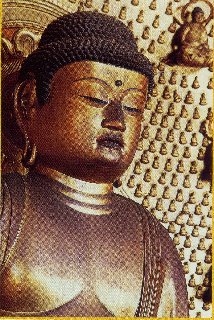Amida bodhissatva
It is very difficult to explain Buddhism concepts in one page or two. Speaking very generally, however, one can say that Buddhism concepts of rebirth, monasticism and self-effort are thus;
Man was fated to suffer in existence for so long as he remained attached to an illusory, sinful world and to his own selfish desires. The only escape was to listen to the Buddhist message, enter a monastery, and once there learn to rid himself of any sense of attachment. To this stock of basic ideas the Buddhists added some equally important dogmas of their own.
One of these was the bodhissatva ideal. Bodhisstava were a class of exceptional beings who had acquired sufficient merit to enter nirvana (a state of enlightenment where he would cease to be reborn), but had given up this reward in the interests of helping others along the path to enlightenment.
The role of bodhissatva in Buddhism is similar to thats of saints in Christianity. It was believed that a bodhissatva would increase the spiritual purity and welfare of those who prayed to him.
 The Amida( Amita in Sanskrit) bodhissatva is supposed to have made a great vow, declaring that he would not enter nirvana until all other beings could do so. Also, it is believed that when one died, the Amida bodhissatva would come down to welcome the died and take him back to the Amida's Pure Land.
The Amida( Amita in Sanskrit) bodhissatva is supposed to have made a great vow, declaring that he would not enter nirvana until all other beings could do so. Also, it is believed that when one died, the Amida bodhissatva would come down to welcome the died and take him back to the Amida's Pure Land.
The picture is Amida bodhisattva statue (the height: 5.15meters) in the main hall of Kichidenji. It is said that the statue was made by Genshin.
The statue is designated by Government as an Important Cultural Asset.
The picture of the statue is copied one of post card.
citation and reference;
Richard Mason, John Caiger. "A History of Japan", Tuttle Publishing (Originally published by Cassell Australia)
 The Amida( Amita in Sanskrit) bodhissatva is supposed to have made a great vow, declaring that he would not enter nirvana until all other beings could do so. Also, it is believed that when one died, the Amida bodhissatva would come down to welcome the died and take him back to the Amida's Pure Land.
The Amida( Amita in Sanskrit) bodhissatva is supposed to have made a great vow, declaring that he would not enter nirvana until all other beings could do so. Also, it is believed that when one died, the Amida bodhissatva would come down to welcome the died and take him back to the Amida's Pure Land.